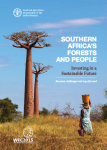Produced by the Food and Agriculture Organization of the UN (FAO) for the XIV World Forestry Congress (WFC), to be held the 7-11 September 2015, in Durban, South Africa, 'Southern Africa's Forests and People' provides a country-by-country analysis of the challenges facing the forestry sector and best practices that have been developed in Southern Africa.
The publication covers Angola, Botswana, the Comoros, Lesotho, Madagascar, Malawi, Mauritius, Mozambique, Namibia, Seychelles, South Africa, Swaziland, Tanzania, Zambia and Zimbabwe.
 September 2015: Produced by the Food and Agriculture Organization of the UN (FAO) for the XIV World Forestry Congress (WFC), to be held from 7-11 September 2015, in Durban, South Africa, the report titled ‘Southern Africa’s Forests and People’ provides a country-by-country analysis of the challenges facing the forestry sector and best practices that have been developed in Southern Africa.
September 2015: Produced by the Food and Agriculture Organization of the UN (FAO) for the XIV World Forestry Congress (WFC), to be held from 7-11 September 2015, in Durban, South Africa, the report titled ‘Southern Africa’s Forests and People’ provides a country-by-country analysis of the challenges facing the forestry sector and best practices that have been developed in Southern Africa.
The publication covers Angola, Botswana, the Comoros, Lesotho, Madagascar, Malawi, Mauritius, Mozambique, Namibia, Seychelles, South Africa, Swaziland, Tanzania, Zambia and Zimbabwe. The information for each country was submitted by the respective heads of forestry and forestry departments. The analysis comprises an introduction to the forestry sector in each country; key challenges in the sector; best practices, including some encouraging success stories; and future interventions planned to strengthen the sector and increase its impact. The objectives of the publication are to share lessons learned from Southern Africa with other important forest regions and to build a platform for enhancing collaboration across the countries in the sub-region and with other regions.
The report shows that initiatives aimed at promoting awareness and knowledge about the conservation and sustainable development of all types of forests are starting to bear fruit. Public participation in programmes such as South Africa’s Champion tree project has been encouraging. Other best practices and success stories include: management programmes to combat forest fires and desertification; reforestation, agroforestry and tree planting outside forests; increasing collaboration with stakeholders and funders; capacity development within the sector, especially with regard to research and development; creating protected areas to safeguard natural forest; and concerted efforts to protected endangered forest species.
The publication will be launched at a special WFC side-event on 7 September. [Publication: Southern Africa’s Forests and People: Investing in a Sustainable Future. Successes, challenges and ways forward] [XIV WFC Website] [IISD RS Coverage of XIV WFC]